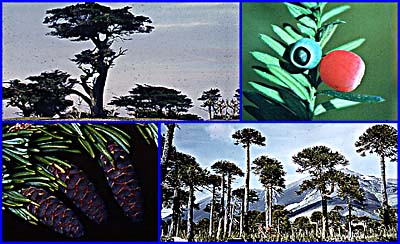Introduction to the Conifers
not just for Christmas anymore


While conifers may not be the most diverse or most numerous plants alive today, they are certainly among the most familiar and easiest to recognize. Conifers are the "cone-bearing" plants, and include pine, redwood, spruce, yew, cedar, and many other familiar trees. Conifers are also economically important, being some of the most common timber and paper-pulp trees. Both the tallest and most massive organisms ever to have lived on land are conifers as well as some of the longest-lived.
Conifers are seed plants, and like most other seed plant groups they have wood, megaphyllous leaves, and of course seeds. These seeds are typically produced in woody cones, though the cones of some conifers are reduced to such a degree that they are no longer recognizable as such. The cones of the juniper, for instance, are fleshy and blue; they are often called "berries", and are used in the flavoring of gin and the seasoning of certain foods. Pine "nuts" are also important edible seeds produced by conifers.
Conifers have been around since the Paleozoic, though modern conifer groups diversified and were of greatest importance during the Mesozoic Era. As such, they were probably important sources of food for plant-eating dinosaurs such as sauropods.
A guide to Trees of the Pacific Northwest, with numerous pictures of conifers, is available from Oregon State University. Or get more information on bristlecone pines from the Ancient Bristlecone Pines Web page.
Visit the Robert C. Williams American Museum of Papermaking.


